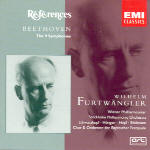The chief concern here for collectors is how EMI’s latest remasterings of its Furwängler Beethoven cycle compare to previous ones. Symphonies One, Three, Four, Five, Six, and the live Bayreuth Ninth have marginally more bloom and less stridency on top, with richer, more defined bass response. The Seventh is slightly cleaner, while the relatively poor sound of the live Second and Eighth are heard to their best advantage. If you already own EMI’s earlier Références Furtwängler Beethoven edition, there’s no need to replace it. But if you’re buying these recordings for the first time, this is the set to get, and it now takes up less shelf space. Contrary to received opinion, there are no fundamental differences between Furtwängler’s studio Third, Fifth, and Sixth and their numerous live counterparts. True, the live versions (whether played by the Vienna or Berlin Philharmonics) boast flights of fanciful phrasing plus local dynamic and color effects unique to the occasion. Yet, by and large, the studio versions are more disciplined ensemble-wise, better engineered, and thus more conducive to repeated listening. Conversely, the famous 1951 Bayreuth Ninth yields to the altogether superior 1954 live Lucerne Ninth with the Philharmonia Orchestra. The Philharmonia simply outplays its Bayreuth colleagues section for section. Compare, for example, the horns in the slow movement, the winds in the scherzo, or the finale’s cello recitatives and you’ll hear what I mean. I also find the Furtwängler/Vienna 1954 Seventh from Salzburg (Orfeo) more exciting yet tightly controlled and benefiting from superior sound. In any event, EMI also has released these five discs individually for those who don’t wish to go the whole hog. Richard Osborne’s annotations are remarkably frank and informative.
































